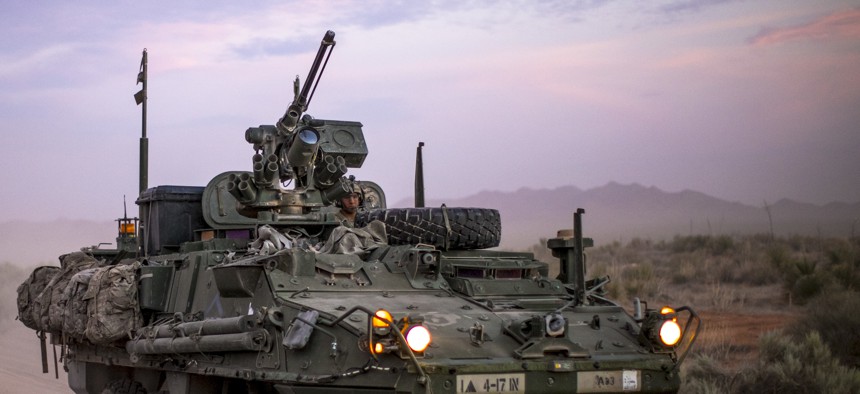
STRYKER assigned to 1st Brigade Combat Team, 4-17 Infantry Battalion passed the Combat Aviation Brigade's convoy on the way to Division's wide Iron Focus field exercise. Photo by Spc. TIN P. VUONG 1st Armored Division Combat Aviation Brigade
US, Allies Push Armor and Rockets Into Ukraine
The aid package comes amid worries about a Russian spring offensive.
Ninety Stryker armored vehicles, 59 more Bradley Fighting Vehicles, and a large number of rockets and artillery rounds will go to Ukraine in a new military aid package valued at $2.5 billion, the Biden administration announced Thursday.
The announcement came a day ahead of a meeting of the Defense Contact Group, an assembly of nations that have pledged to support Kyiv as it fights off Russian invaders. It will take weeks to train Ukrainian troops on a previous group of Bradleys. Some observers expect Russia to launch a new offensive in the spring.
The new package also includes:
• More munitions for National Advanced Surface-to-Air Missile Systems (NASAMS);
• Eight Avenger air defense systems;
• 295,000 25mm rounds for the Bradley Fighting Vehicles
• 53 Mine Resistant Ambush Protected Vehicles (MRAPs);
• 350 High Mobility Multipurpose Wheeled Vehicles (HMMWVs);
• 20,000 155mm artillery rounds;
• About 600 precision-guided 155mm artillery rounds;
• 95,000 105mm artillery rounds;
• About 11,800 120mm mortar rounds;
• Additional ammunition for High Mobility Artillery Rocket Systems (HIMARS);
• 12 ammunition support vehicles;
• Six command post vehicles;
• 22 tactical vehicles to tow weapons;
• High-speed Anti-radiation missiles (HARMs);
• About 2,000 anti-armor rockets;
• More than 3 million rounds of small arms ammunition;
• Demolition equipment for obstacle clearing;
• Claymore anti-personnel munitions;
• Night vision devices;
• Spare parts and other field equipment.
Air defenses remain a critical need for the Ukrainians, defense undersecretary for policy Colin Kahl told reporters at the Pentagon on Wednesday. This week alone, a Russian barrage on the city of Dnipro killed 45 civilians, including six children.
But they also need new and heavier forms of ground armor to push the Russians from their entrenched positions in the south and east of the country.
“We've really been focused on air defense in the in the last few months," Kahl said. "I think there is a sense that after, you know, the kind of remarkable success the Ukrainians had up in the north around Kharkiv, and then the success they had down in Kherson to push the Russians back to the east side of the river…that with the winter months, the fighting is not stopped but what has shifted and the Russians are really digging in. They're…digging trenches. They’re bringing these Dragon's Teeth [concrete barriers], laying mines."
The White House said Russia’s “most recent air attacks against Ukraine’s critical infrastructure again demonstrate the devastating impact of Russia’s brutal war in Ukraine. This package provides additional NASAMS munitions and Avenger air defense systems to help Ukraine counter a range of short and medium range threats and bolster Ukraine’s layered air defense.”
This package will add to other military gear and munitions from other countries. The United Kingdom this week said it will send a squadron of Challenger 2 tanks and another 100,000 artillery rounds. In a joint statement on Thursday, the governments of Estonia, Poland, Latvia, Lithuania, Denmark, the Czech Republic, the Netherlands, and Slovakia said they would send a variety of items including 155mm FH-70 and 122mm D-30 howitzers, (Estonia), two Mi-8 helicopters (Lithuania), and S-60 anti-aircraft guns with 70,000 pieces of ammunition (Poland).
But the list was missing some expected items, such as German Leopard 2 tanks. German Chancellor Olaf Scholz has been reluctant to send the tanks, but has hinted that Bonn might reconsider mind if the United States sent M1 Abrams tanks.
Kahl said Wednesday the Abrams is too fuel-thirsty and complex to help Ukraine. Meanwhile, Poland said in the joint statement that it would be willing to send a company of Leopard 2 tanks from its own arsenal, but did not make a firm commitment.
“Pending this, a wider coalition of Leopard 2 tanks donors will be established,” the statement said.




